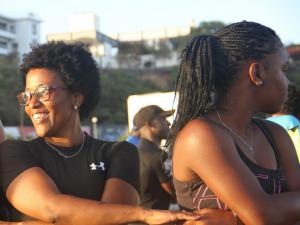Improving adolescent and youth health services
Kinshasa – Nineteen-year-old Armande* recalls her disastrous first visit to a health centre.
“It was awful,” says the teen from Kongo Central, in western Democratic Republic of the Congo. “I was younger then and looking for information on HIV, and the nurse there made fun of me in front of everyone because of my age.”
Adolescents face a range of health and societal problems: sexually transmitted infections, including HIV, sexual violence, early and unwanted pregnancy, and early marriage.
In Democratic Republic of the Congo, the government is working to provide access to quality sexual and reproductive health services to adolescents and youth. According to the Strategic Plan for Health and Wellbeing for Adolescents and Youth (2021–2025), a third of the population is aged between 10 and 24 years. Yet only 17% of youth and adolescents used health services in 2021.
To improve service quality, World Health Organization (WHO) has supported the implementation of an innovative collaborative learning project backed by the Global Fund. Service providers work together to identify, discuss and propose solutions for common problems – all while strengthening capacity and developing positive attitudes, which then feed into the health services provided to adolescents.
“Young people and adolescents need services that are tailored to them,” says Fidèle Mbadu Muanda, Director of the National Programme of Adolescent Health. “Collaborative learning is about strengthening capacities and changing attitudes among service providers. We’ve aligned the norms and policies linked to youth-oriented health services according to WHO guidance.”
In addition to providing technical guidance for the project, WHO supported trainings and the design of quality materials for providers.
For Dr Symplice Mbola Mbassi, adolescent and youth health specialist at the WHO Regional Office for Africa, collaborative learning is innovative on multiple counts.
“It allows people to take stock and identify for themselves what needs to be addressed, as opposed to classical approaches to training, where the themes tend to be imposed on trainees. They teach and inspire each other from their own experience and good practices,” she says.
The project was launched in the Democratic Republic of the Congo over 2018 and 2019, covering six districts in the provinces of Western Kasai (Mbuji-Mayi) and Kinshasa. Jeannette Mudipanu, a nurse in Makala’s Saint Clément Hospital Centre who participated in one of the 32 sessions, says she experienced a profound shift in perspective.
“It’s important to understand the individual,” she said. “From there, we must take the time to listen, patiently and without judgment.”
Youth attendance is now up at Saint Clément: available data shows that around 600 adolescents visited the centre between July and December 2020, as compared with 280 over the same period for the previous year. Exit interviews show a 100% satisfaction rate with the services received.
The new approach was evident right away when Armande visited.
“It was night and day,” she says, comparing it with her first experience. “The first thing I noticed was the way I was greeted. The nurse saw me in a private space and responded to my questions without judgment. I got advice on how to prevent sexually transmitted infections, including HIV, avoiding early and unwanted pregnancy, and how to use a condom. She did mention abstinence as the best choice but also acknowledged that it can be hard for young people like us to stick to. Most importantly, she corrected some of the misinformation that’s been going around.”
Service providers seize each opportunity to refute some of the most harmful myths in circulation.
“I had heard that the lubricant on condoms causes cancer, so I used to absolutely avoid those condoms,” Armande admits. “I also used to think that having sex was the only way to transmit HIV.”
HIV/AIDS prevalence among Congolese youth aged 15 to 24 is 0.23%, as compared to a national average of 1.2%, according to Spectrum 2021 and the Demographic and Health Survey (EDS 2013 – 2014). Mortality due to early pregnancy remains a scourge: according to the 2021 Maternal and Perinatal Death Surveillance and Response Report, youth and adolescents under age 19 account for 11% of deaths.
Based on initial success and lessons learned in the six pilot districts, the project now aims to scale the collaborative learning approach to 25 zones in five provinces.
*Name has been changed.
Communications Officer
WHO DRC
Tel : +243 81 715 1697
Office : +47 241 39 027
Email: kabambie [at] who.int (kabambie[at]who[dot]int)
Communications Officer
WHO Regional Office for Africa
Email: dialloka [at] who.int (dialloka[at]who[dot]int)
